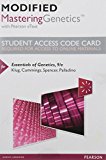
Concept explainers
HOW DO WE KNOW?
In this chapter, we focused on how DNA is replicated and synthesized. In particular, we elucidated the general mechanism of replication and described how DNA is synthesized when it is copied. Based on your study of these topics, answer the following fundamental questions:
(a) What is the experimental basis for concluding that DNA replicates semiconservatively in both prokaryotes and eukaryotes?
(b) How was it demonstrated that DNA synthesis occurs under the direction of DNA polymerase III and not polymerase I?
(c) How do we know that in vivo DNA synthesis occurs in the 5' to 3' direction?
(d) How do we know that DNA synthesis is discontinuous on one of the two template strands?
(e) What observations reveal that a "telomere problem" exists during eukaryotic
Want to see the full answer?
Check out a sample textbook solution
Chapter 10 Solutions
Modified Mastering Genetics with Pearson eText -- Standalone Access Card -- for Essentials of Genetics (9th Edition)
- In terms of the new DNA strands that are generated, what are the differences between replication and conventional polymerase chain reaction?arrow_forwardThe Meselson-Stahl experiment provided strong evidence that DNA replication was conservative, by alternately growing bacteria in medium with heavy 15N and light 14N. If DNA replication were dispersive, what result would Meselson and Stahl have observed after the first round of DNA replication in light nitrogen? Group of answer choices Two bands, one at the location for pure 15N and one at the location for pure 14N. One band, located half way between the locations for pure 15N and pure 14N. Two bands, one at the location for pure 15N and one located halfway between the locations for pure 15N and pure 14N. None of these Three bands, one at the location for pure 15N, one at the location for pure 14N, and one at a location halfway between.arrow_forwardIn terms of new DNA strands that are generated, what are the differences between replication and conventional polymerase chain reactions?arrow_forward
- A circular molecule of DNA contains 1 million base pairs. If the rate of DNA synthesis at a replication fork is 100,000 nucleotides per minute, how much time will theta replication require to completely replicate the molecule, assuming that theta replication is bidirectional? How long will replication of this circular chromosome by rolling-circle replication take? Ignore replication of the displaced strand in rolling-circle replication.arrow_forwardIdentify two important enzymes involved in replication. Where does replication occur in the cell? What is the product of replication? Why is replication important to the cell and living organism? What is the process of copying DNA called?arrow_forwardWhen DNA replication was investigated by using heavy, N15 DNA to mark the original molecules, and light, N14 DNA to mark the newly synthesized molecules, one band was found in the middle of the centrifuge column after one round of replication, and two bands were found (middle and top of column) after 2 rounds of replication. Imagine that after 1 round of replication 2 bands were found, one at the bottom and one at the top of the centrifuge column. In that case, what model of DNA replication would have been supported? The dispersive model The conservative model The Franklin model The semi-conservative modelarrow_forward
- Suppose that 28% of the nucleotides in a DNA moleculeare deoxythymidine 5′- monophosphate, and that duringDNA replication the percentage amounts of availablenucleotide bases are 22% A, 22% C, 28% G, and 28% T.Which base would be depleted first in the replicationprocess?arrow_forwardThe chromosome of E. coli contains 4.6 million bp. How long will it take to replicate its DNA? Assuming that DNA polymerase III is the primary enzyme involved and that it can actively proofread during DNA synthesis, how many base pair mistakes will be made in one round of DNA replication in a bacterial population containing 1000 bacteria?arrow_forwardWhat factors promote the fidelity of replication during the synthesis of the leading strand of DNA? Would you expect the lagging strand to be made with the same fidelity? Why or why not? Explain your answer briefly.arrow_forward
- In bacterial cells, nucleotide excision repair involves which of the following proteins? DNA glycosylase AP endonuclease photolyase AlkB UvrABC proteins If Meselson and Stahl had results from density gradient analysis of bacterial DNA that indicated only two bands, one of the original density and one that was the same as unlabeled DNA, and no intermediate density band, this would indicate that DNA replication is: constructive semiconservative conservative consecutive cannot determine from the information given 6.In E. coli, which DNA polymerase is primarily responsible for filling in the gaps in the DNA generated during nucleotide excision repair? DNA polymerase I DNA polymerase II DNA polymerase IV DNA polymerase V none of the abovearrow_forwardWhat enzymatic features of DNA polymerase prevent it from replicating one of the DNA strands at the ends of linear chromosomes? Compared with DNA polymerase, how is telomerase different in its ability to synthesize a DNA strand? What does telomerase use as its template for the synthesis of a DNA strand? How does the use of this template result in a telomere sequence that is tandemly repetitive?arrow_forwardWho experimentally prove that DNA replication is semi conservative?arrow_forward
 BiochemistryBiochemistryISBN:9781305577206Author:Reginald H. Garrett, Charles M. GrishamPublisher:Cengage Learning
BiochemistryBiochemistryISBN:9781305577206Author:Reginald H. Garrett, Charles M. GrishamPublisher:Cengage Learning Human Heredity: Principles and Issues (MindTap Co...BiologyISBN:9781305251052Author:Michael CummingsPublisher:Cengage Learning
Human Heredity: Principles and Issues (MindTap Co...BiologyISBN:9781305251052Author:Michael CummingsPublisher:Cengage Learning

